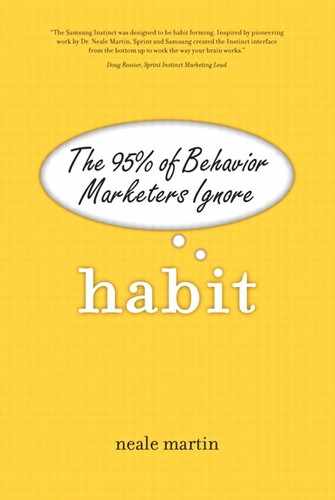11. Habit Maintenance
The most counterintuitive argument in this book is that companies don’t want their customers to think about them, especially if the company is the market leader. If your customers are cruising on autopilot, leave them alone. If the repurchase behavior is dislodged from habit and raised to executive mind awareness, other brands might fall into consideration. Also, the customers might modify their purchase behavior. Let’s look at a few scenarios in which this happens.
Any change to a product—including features, performance, appearance, price, or channel of distribution—risks moving a habit into executive mind review. I was surprised when my wife returned from shopping to replace our Ford Explorer that was totaled in an accident. She had really liked the Explorer, and I assumed she would get another. But she returned from the dealership disappointed, saying she didn’t like the size of the new model. Of course, the larger size might have expanded the Explorer’s appeal overall—I use this example to simply illustrate the point. Any change represents some level of risk.
However, not keeping the product updated can also disrupt habitual behavior. This is not a contradiction, but recognition that the brand promise is linked to maintaining the relationship in a changing marketplace. Not being able to keep an offer current is another form of breaking the brand promise. Hotel chains face tremendous costs to upgrade their properties, but if they don’t, they face the slow erosion of customers. Kmart’s neglect of its stores made the company look and feel outdated and cheap, and fall out of favor with customers and Wall Street. Palm, previously viewed as a top innovator in handsets, faced criticism for keeping its form factor stable for too long—a couple of years. Tellingly, Palm hired former iPod lead designer Jon Rubinstein to help the company innovate.
Similarly, changing the underlying nature of the deal can dislodge existing habits, even if a company is sweetening the deal. Many sales promotions experience this drawback. Altering the nature of the deal interrupts automatic repurchase. The deal might become the new cue, as with coupons and annual sales.
Raising prices invariably risks elevating repurchase to executive review. Either stay below the range of indifference in price hikes or clearly articulate the reason for increase. Automobile companies were able to raise their prices for years by extending the payment plan thus keeping monthly payments the same. Conversely, the electronics industry faces relentless downward pressure on pricing. Branding can help make a product less sensitive to pricing pressures.
